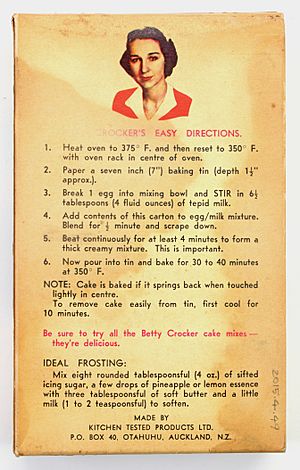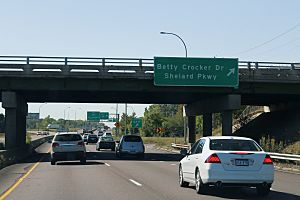Betty Crocker facts for kids
 |
|
| Owner | General Mills |
|---|---|
| Country | United States |
| Introduced | 1921 |
| Markets | Worldwide |
Betty Crocker is a famous brand and a made-up character. She is used in ads for food and recipes. The character was first created by the Washburn-Crosby Company in 1921. This happened after a contest in The Saturday Evening Post.
In 1954, General Mills started using the red spoon logo with her signature. You could find it on their Gold Medal flour, Bisquick, and cake mix boxes. A picture of Betty Crocker also appears on ads and product packages. This picture has been updated many times since 1936.
Betty Crocker was created to help answer questions from customers. The name "Betty" was chosen because it sounded cheerful and American. "Crocker" was added to honor William Crocker, a company director. Her image has been updated seven times. Each update showed new fashions and hairstyles.
Betty Crocker is seen as an important American symbol. Her image has lasted for many generations. It has changed with social, political, and economic trends. She appears in ads, books, music, and comics.
Contents
How Betty Crocker Was Created
Betty Crocker was created in 1921. This was done by Washburn-Crosby and an advertiser named Bruce Fairchild Barton. The idea for Crocker came from a cook at Franklin College. This cook made tasty baked goods. Later, Washburn Crosby joined with other companies. They formed General Mills in 1928.
In 1924, Betty Crocker got a voice. This happened with "The Betty Crocker Cooking School of the Air." It was the country's first radio cooking show. It started on one station in Minneapolis. The show became very popular. Soon, it was broadcast across the country on NBC Radio. Several women played Betty Crocker on the radio and at cooking schools. They kept their real names a secret.
In 1929, Betty Crocker coupons were introduced. These coupons were put inside bags of flour. You could use them to get discounts on Oneida Limited flatware. This idea became very popular. By 1932, General Mills offered a full set of flatware. The coupons were later printed on the outside of packages. They told people to save them for kitchen items from a mail-order catalog.
Betty Crocker Cookbooks
Since 1930, General Mills has released many recipe books. In 1933, they published Betty Crocker's 101 Delicious Bisquick Creations. This book showed how famous people made Bisquick dishes.
During wartime, the Betty Crocker Cook Book of All-Purpose Baking was published. It helped people cook with wartime rules in mind.
In 1950, the Betty Crocker Picture Cookbook came out. A nutritionist named Agnes White Tizard wrote it.
In 2005, the 10th edition of the Betty Crocker cookbook was released. A Spanish/English book was also published. It had common recipes for Spanish speakers. An 11th edition came out in 2011. Many other Betty Crocker recipe books were available in 2015. You can also find her recipes online.
Betty Crocker in Media
Betty Crocker shows first appeared on local radio stations in 1924. The first national Betty Crocker broadcast was on NBC in 1926. The show stayed on network radio until 1953. It was mostly on NBC or CBS.
Several actresses played Betty Crocker. Marjorie Husted was on radio for twenty years. Adelaide Hawley Cumming played her on television from 1949 to 1964.
In 1949, actress Adelaide Hawley Cumming became the TV Betty Crocker. She appeared on The George Burns and Gracie Allen Show. She also had her own TV show, Betty Crocker Star Matinee. She was even in the first color commercial for CBS. She continued to play Betty Crocker until 1964.
A picture of Betty Crocker was first drawn in 1936. It was a "motherly image." It combined features of several women from the company's Home Service Department. The artist was Neysa McMein. The portrait changed slightly over the years. It always showed General Mills' idea of an American homemaker. This homemaker was seen as smart and caring. The 1996 portrait of Betty Crocker was partly inspired by a "computer mix" of 75 women. These women came from different backgrounds and ages. These portraits were always paintings. No real person ever posed as a model.
In 1945, Fortune magazine called Betty Crocker the second most popular woman in America. Eleanor Roosevelt was named first.
Betty Crocker's Legacy
The city of Golden Valley, Minnesota, has a street named Betty Crocker Drive. This is where General Mills has its main office.
There are many products with the Betty Crocker brand. These include plastic food containers and measuring cups. There are also small kitchen appliances like popcorn makers.
In 2006, the Betty Crocker catalog business closed. All its items were on sale. A new online store started in April 2007. However, it was later stopped.
Betty Crocker Products
- Bac-Os (no longer made since 2016)
- Betty Crocker Brownie bar
- Betty Crocker Cookbook
- Betty Crocker baking mixes
- Bisquick
- Fruit Roll-Ups
- Betty Crocker canned frosting
- Bowl Appetit shelf-stable entrees
- Betty Crocker Soda Licious (no longer made)
- Cake and dessert decorating products
- Dunkaroos
- Fruit by the Foot
- Fruit Gushers
- Hamburger Helper and similar products
- Potato Buds instant mashed potatoes
- Suddenly Salad mixes
- "Shake and make" pancake mix
- Warm Delights microwavable desserts
See also
 In Spanish: Betty Crocker para niños
In Spanish: Betty Crocker para niños



